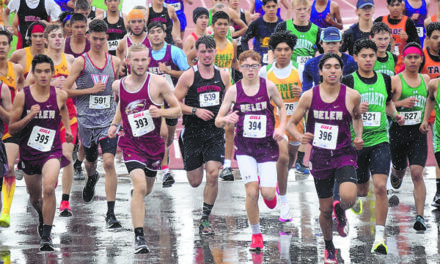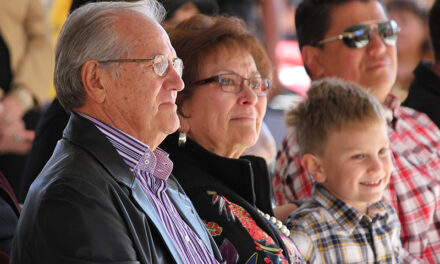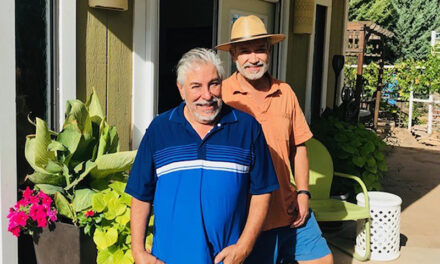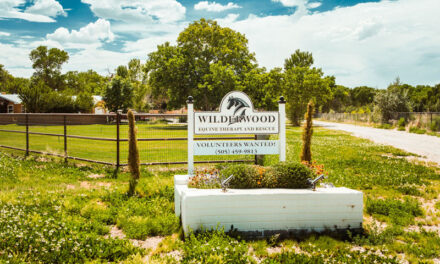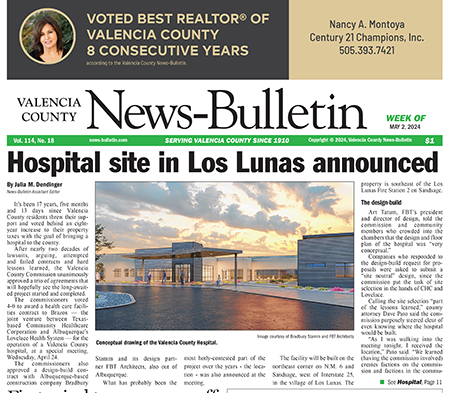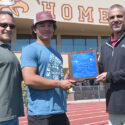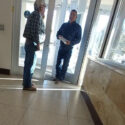La Vida
In our previous story, we discussed the history of mountain monograms and focused on those in Raton, Socorro and Belen.
This article talks about the two “Ls” in Los Lunas, the “J” on Albuquerque’s west side and the current practice of decorating water storage tanks along the highways and byways.
The “Double-L” on El Cerro de Los Lunas
Some alumni of Los Lunas High School recall that the L or Ls on Los Lunas Hill was on the hill in the early 1950s, although whether it was one L or two is not clear.
Scott Edeal believes that his class, 1965, may have added the second L on El Cerro de Los Lunas to the one that was already there. None of the editions of the LLHS yearbook, “La Luna,” between 1939 and 1965 makes any mention of the mountain monogram, so maintaining it may not have been a school-sanctioned activity in those early years.
In the early days, there were no roads or trails up the hill, so the paint or whitewash had to be manhandled up “through the wild.” The land on which the monograms are painted was owned by the Huning Limited Liability Corporation until 2008 when it was donated to the village of Los Lunas. The Hunings have records of access permission dating back to 1990, so the event eventually did become a sanctioned activity.
In 1979, the task of refurbishing the Ls was taken over by the National Honor Society at Los Lunas High School. Chuck McGarrah of that illustrious class recalls the process and some of the shenanigans and dangers that accompanied the painting:
Trucks were loaded and driven up the mountain as far as possible, and from there we carried the lime and water the rest of the way. Lime and water were mixed, and the LLs painted. A small lime fight also took place (not a good thing). We were done and back down by noon for lunch at the Lot-a-Burger. Long time ago. I do remember the view as great. First and last time I was there. I was in the crossfire of the idiots throwing the lime around, and I got hit right in the eyes. There was almost no water, so my eyes didn’t get cleaned out that good. I had to go to an eye doctor in Albuquerque. Never did join the NHS after that incident.
Sometime after 1979, the task of freshening the letters and updating the numbers reverted to the junior class at LLHS. They would go up late in the year and repaint/reorganize the rocks and update the numbers to reflect their incoming status as seniors.
Helen Saiz remembers taking two, five-gallon buckets of white paint up the hill. She recalled she couldn’t believe how big the boulders were.
Berna Otero of the class of 1984 remembers climbing the hill with six of her classmates on the morning of graduation and changing some of the rocks to say “84.” She believes this was the first time numbers accompanied the letters, and she and her classmates did not believe the tradition would continue. It clearly has!
Afraid they might get caught, they took a police radio to stay alert. Her comment was, “It was hilarious — Good times!”
Apparently, there were also occasions when rival schools would sneak up onto the hill and rearrange the rocks to form another letter, perhaps a B!
The J on Volcon
As with many other schools, initiation traditions at the College of St. Joseph on the Rio Grande (later the University of Albuquerque and now St. Pius X High School) became a part of welcoming new students.
One of these traditions was “refreshing” the painted stone J (for Joseph) on Volcon, one of the nearby volcanoes. The J, installed and initially whitewashed in 1951, was 176-feet tall and 60-feet wide. It had been laid out by an engineer from Sandia Base and was placed on a 45-degree incline on the center volcano to be visible for miles around.
Matt Baca, a 1953 freshman at St. Joseph, recalled joining other freshmen in their trek up the volcano to paint the J. He said once the task had been completed, the crew was given a picnic at the Doc Long picnic area in the Sandias.
Baca, a country boy from Adelino, said they served potato salad, a dish he had never tasted before. This was his fondest memory of that day.
Controversy over the J arose almost immediately. People said it was “rash” and “unartistic.” One nearby resident complained, “one of our views has been cheapened. I refer to the painting of the J on the center volcano by the freshmen of St. Joseph College.”
When presidential candidate John F. Kennedy visited Albuquerque during his 1960 campaign, he noticed the J while he was being chauffeured to the University of New Mexico’s Newman Center for Mass. There are two stories about his reaction.
In one, he apparently turned to his host and asked, “Did they do that for me?” In the other he “expressed astonishment at the prominent J and supposed it had been the work of Senator Lyndon Johnson’s sympathizers to dampen JFK’s spirits.
On April 2, 1971, when students returned to the J, they went not to re-whitewash it but to dismantle it. The tradition, which had been known as “J Day” and was usually a day without classes, became known as “un-J Day.”
Instructors were told that they could let students skip class. In an undated Faculty News Bulletin, it was suggested this effort to “obliterate the J” would be good for the environment and good publicity for the school.
The symbol of St. Joseph on the Rio Grande, which had piqued presidential candidate John F. Kennedy’s curiosity, would no longer be there on the hillside. In a letter to the editor of the Albuquerque Journal, an environmentally-conscious citizen wrote, “We certainly can all be proud of the students of today who will take the time and effort to obliterate the carefree but destructive doodlings of another generation.”
As it turns out, the obliteration was not total. Today, if the sun angle is just right you can still see the faint image of the J from I-25. (Please don’t try to look if you are driving!)
The removal of the long-standing symbol was not without its opponents. A survey in 1966 had shown that most members of the student body were in favor of keeping the symbol (although a few suggested making it an A), and a student group started a “Save the J” campaign, asking “Will Mount Rushmore be next?”
Another opponent of removing the icon noted, “Considering the amount of visual pollution such as power lines, billboards, and the like, the battle over the painted letters is hardly worth the effort.”
Water tanks
Today, local artists memorializing their alma maters have chosen new canvases to show their school loyalty. In particular, the large water tanks that are fixtures along our byways have been adorned with mascots and logos.
Not only are these modern “geoglyphs” closer to their audiences, but they are much easier to paint and can be much more detailed than big letters placed on hills over a mile away.
John Taylor photos
Water tanks along Interstate 25.
(La Historia del Rio Abajo is a regular column about Valencia County history written by members of the Valencia County Historical Society.
The author of this month’s column is John Taylor, a retired engineer from Sandia National Laboratories and board member of the Valencia County Historical Society. He is the author or co-author of 21 books on New Mexico history, including “Murder, Mystery, and Mayhem in the Rio Abajo,” “A River Runs through Us,” “Tragic Trails and Enchanted Journeys,” “Mountains, Mesas, and Memories,” “Years Gone by in the Rio Abajo,” and “History Surrounds Us,” all co-edited with Dr. Richard Melzer.
Opinions expressed in this and all columns of La Historia del Rio Abajo are the author’s only and not necessarily those of the Valencia County Historical Society or any other group or individual.)






